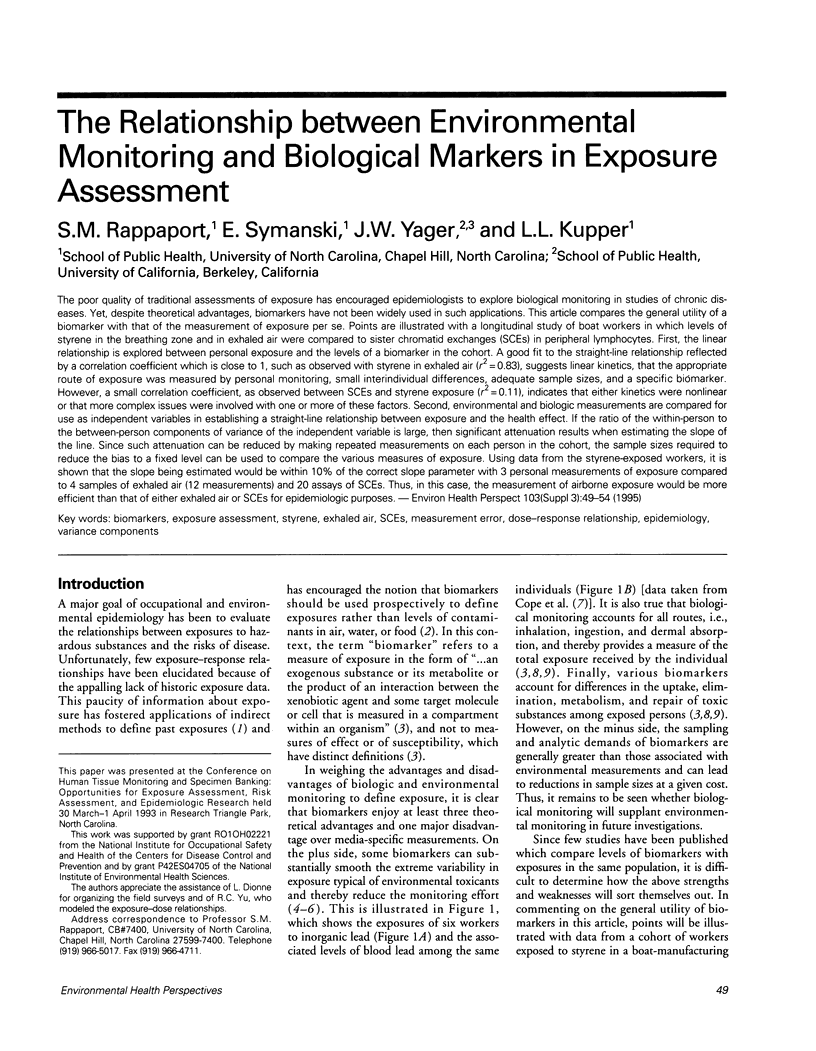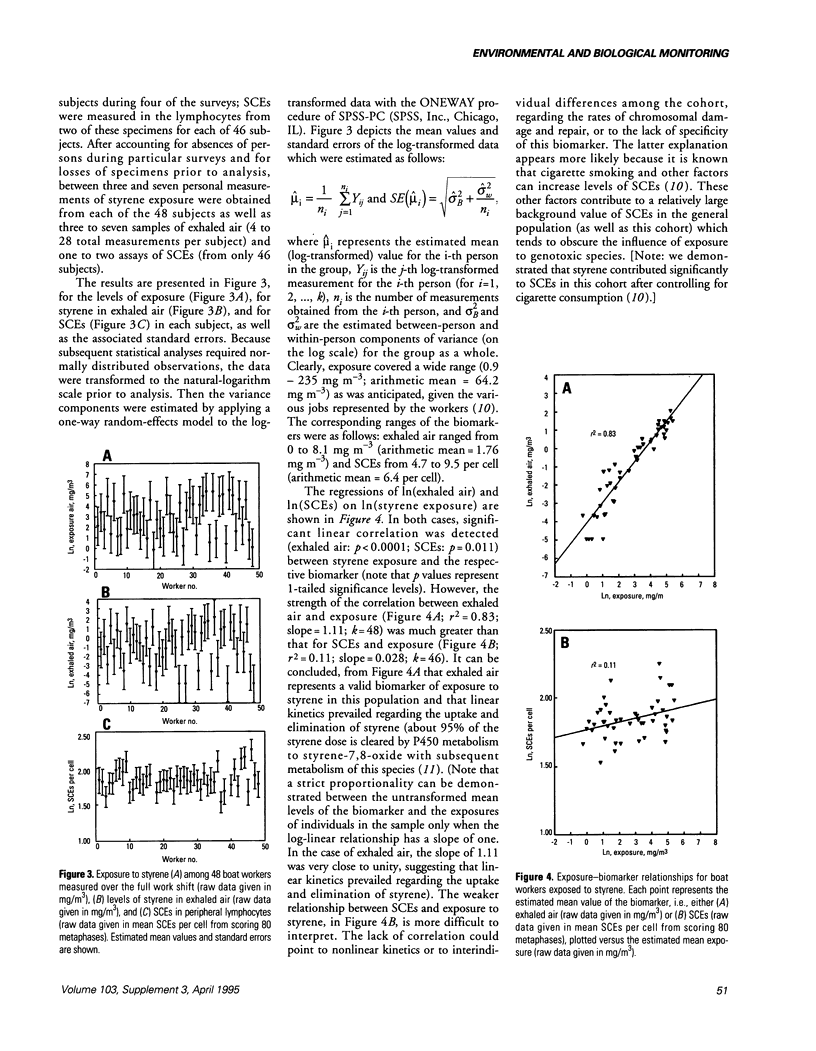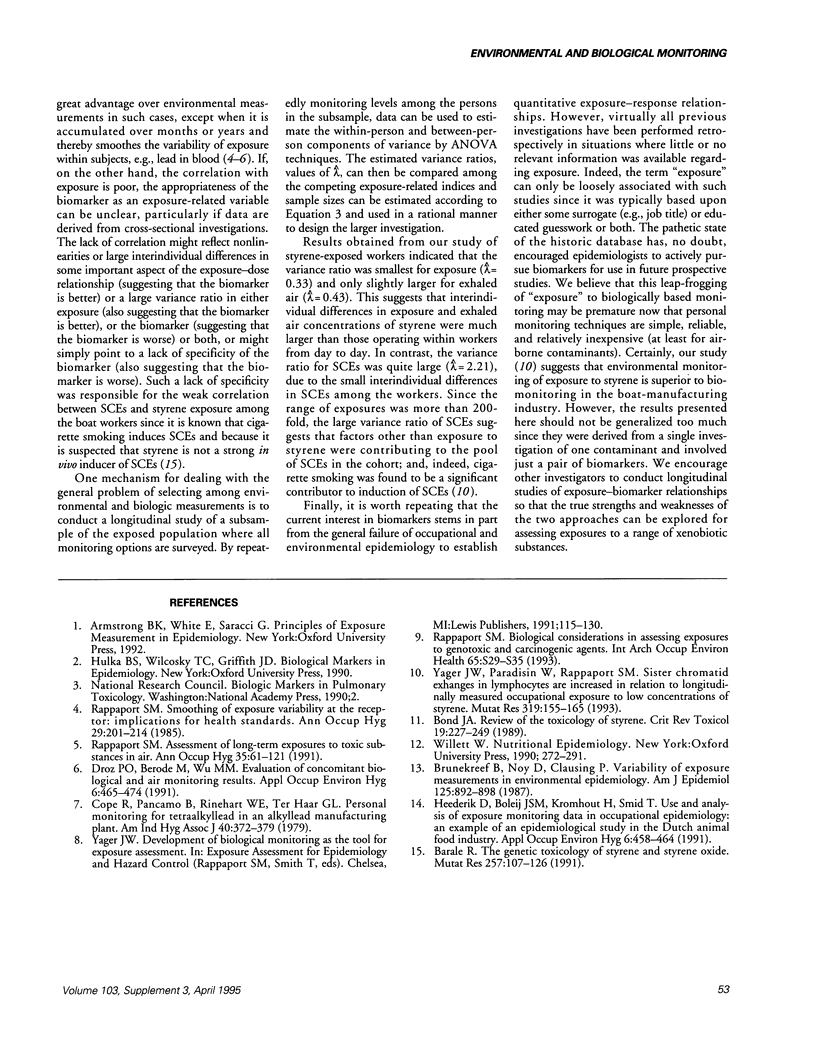Abstract
The poor quality of traditional assessments of exposure has encouraged epidemiologists to explore biological monitoring in studies of chronic diseases. Yet, despite theoretical advantages, biomarkers have not been widely used in such applications. This article compares the general utility of a biomarker with that of the measurement of exposure per se. Points are illustrated with a longitudinal study of boat workers in which levels of styrene in the breathing zone and in exhaled air were compared to sister chromatid exchanges (SCEs) in peripheral lymphocytes. First, the linear relationship is explored between personal exposure and the levels of a biomarker in the cohort. A good fit to the straight-line relationship reflected by a correlation coefficient which is close to 1, such as observed with styrene in exhaled air (r2 = 0.83), suggests linear kinetics, that the appropriate route of exposure was measured by personal monitoring, small interindividual differences, adequate sample sizes, and a specific biomarker. However, a small correlation coefficient, as observed between SCEs and styrene exposure (r2 = 0.11), indicates that either kinetics were nonlinear or that more complex issues were involved with one or more of these factors. Second, environmental and biologic measurements are compared for use as independent variables in establishing a straight-line relationship between exposure and the health effect. If the ratio of the within-person to the between-person components of variance of the independent variable is large, then significant attenuation results when estimating the slope of the line.(ABSTRACT TRUNCATED AT 250 WORDS)
Full text
PDF




Selected References
These references are in PubMed. This may not be the complete list of references from this article.
- Barale R. The genetic toxicology of styrene and styrene oxide. Mutat Res. 1991 Mar;257(2):107–126. doi: 10.1016/0165-1110(91)90021-m. [DOI] [PubMed] [Google Scholar]
- Bond J. A. Review of the toxicology of styrene. Crit Rev Toxicol. 1989;19(3):227–249. doi: 10.3109/10408448909037472. [DOI] [PubMed] [Google Scholar]
- Brunekreef B., Noy D., Clausing P. Variability of exposure measurements in environmental epidemiology. Am J Epidemiol. 1987 May;125(5):892–898. doi: 10.1093/oxfordjournals.aje.a114606. [DOI] [PubMed] [Google Scholar]
- Cope R. F., Pancamo B. P., Rinehart W. E., Ter Haar G. L. Personnel monitoring for tetraalkyl lead in the workplace. Am Ind Hyg Assoc J. 1979 May;40(5):372–379. doi: 10.1080/15298667991429714. [DOI] [PubMed] [Google Scholar]
- Rappaport S. M. Assessment of long-term exposures to toxic substances in air. Ann Occup Hyg. 1991 Feb;35(1):61–121. doi: 10.1093/annhyg/35.1.61. [DOI] [PubMed] [Google Scholar]
- Rappaport S. M. Biological considerations in assessing exposures to genotoxic and carcinogenic agents. Int Arch Occup Environ Health. 1993;65(1 Suppl):S29–S35. doi: 10.1007/BF00381304. [DOI] [PubMed] [Google Scholar]
- Rappaport S. M. Smoothing of exposure variability at the receptor: implications for health standards. Ann Occup Hyg. 1985;29(2):201–214. doi: 10.1093/annhyg/29.2.201. [DOI] [PubMed] [Google Scholar]
- Yager J. W., Paradisin W. M., Rappaport S. M. Sister-chromatid exchanges in lymphocytes are increased in relation to longitudinally measured occupational exposure to low concentrations of styrene. Mutat Res. 1993 Nov;319(3):155–165. doi: 10.1016/0165-1218(93)90075-o. [DOI] [PubMed] [Google Scholar]


